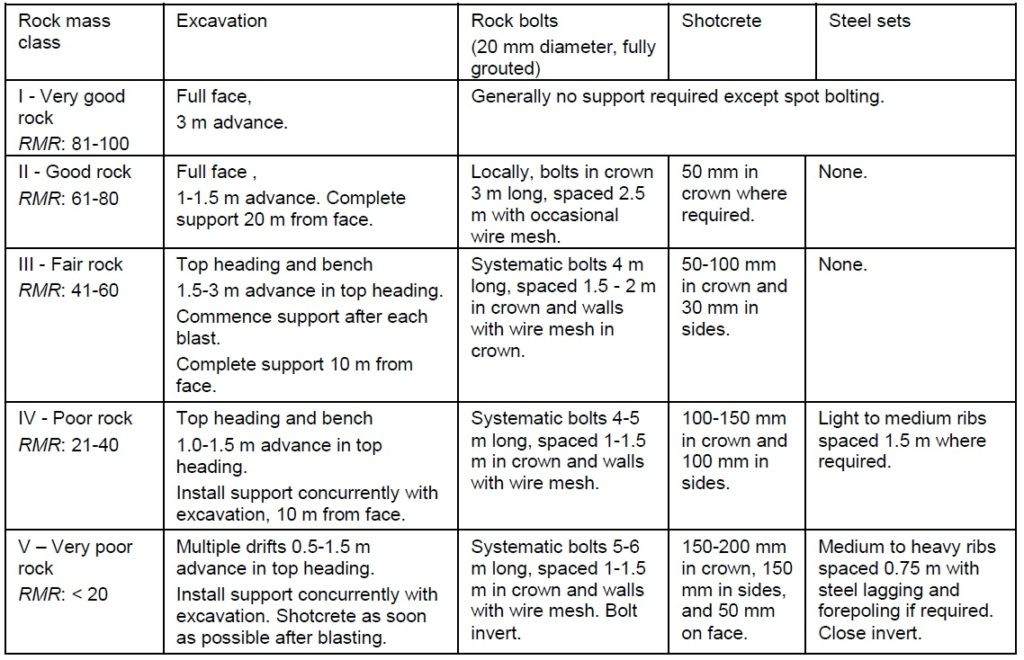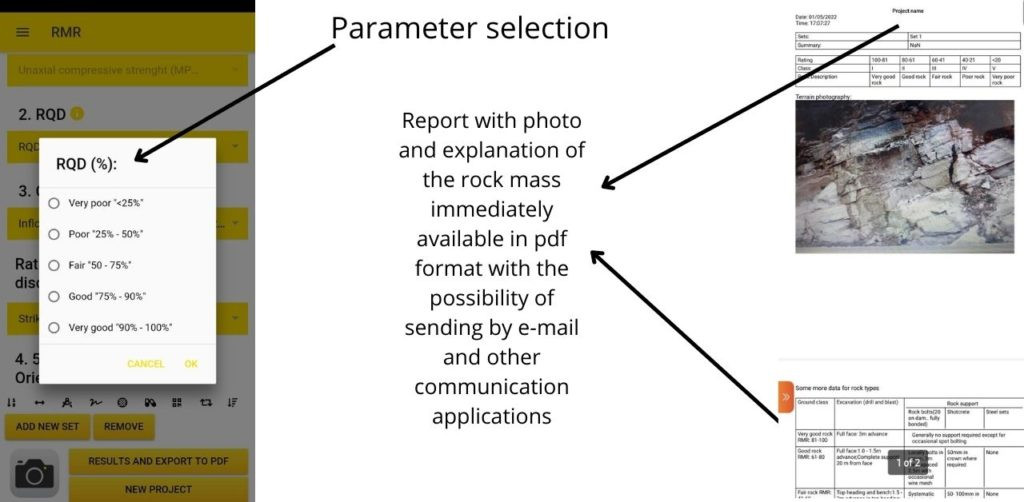The Rock Mass Rating (RMR) system, a cornerstone of geotechnical engineering, was meticulously detailed by Z.T. Bieniawski in 1976. This rock mass classification system, initially known as the Geomechanics Classification, provides a quantitative approach to assessing the quality of rock masses. Over decades, the RMR system has undergone refinements based on extensive case studies, with Bieniawski himself making significant updates to the parameter ratings. This discussion will focus on the 1989 version (Bieniawski, 1989), a widely recognized iteration for evaluating rock mass strength. Both the original 1976 and the refined 1989 versions serve the crucial purpose of estimating rock mass strength using six key parameters. These parameters are fundamental inputs for any Rock Mass Rating Calculator, whether used manually or digitally:
- Uniaxial compressive strength of rock material: The inherent strength of the intact rock.
- Rock Quality Designation (RQD): A measure of fracturing within the rock mass.
- Spacing of discontinuities: The distance between natural breaks in the rock.
- Condition of discontinuities: The characteristics of these breaks, such as roughness and weathering.
- Groundwater conditions: The presence and influence of water within the rock mass.
- Orientation of discontinuities: The direction and angle of these breaks in relation to the engineering structure.
In practical application, utilizing a rock mass rating calculator starts with dividing the rock mass into structural regions. Each region, defined by major geological features like faults or changes in rock type, is classified independently. Significant variations in discontinuity spacing or characteristics within the same rock type may necessitate further subdivision into smaller, more homogenous structural regions for accurate assessment using the RMR system.
The core of the RMR system lies in a structured table that assigns ratings to each of the six parameters. A rock mass rating calculator automates the process of summing these individual ratings to derive a final RMR value. Let’s consider an example to illustrate how these tables, and by extension, a calculator, are used to determine the RMR.
Imagine a tunnel project planned through slightly weathered granite. The dominant joint set dips at 60 degrees against the tunnel drive direction. Laboratory tests indicate a Point-load strength index of 8 MPa, and core logging yields an average RQD of 70%. The joints are slightly rough, slightly weathered, and have a separation of:
Rock Mass Rating (RMR) system table by Bieniawski, illustrating parameters for rock mass classification used in a rock mass rating calculator.
By carefully assessing each parameter against the RMR table—a process simplified by a rock mass rating calculator—we can determine the RMR value for this specific tunnel section.
Bieniawski (1989) also provided essential guidelines linking RMR values to tunnel support requirements. These guidelines, presented in the table below, are invaluable for engineers designing underground excavations in rock masses characterized using the RMR system. It’s important to note that these guidelines were developed for a 10-meter span horseshoe-shaped tunnel, constructed with drill and blast methods, and under specific vertical stress conditions.
For our granite tunnel example with an RMR of 59, the guidelines suggest wire mesh with shotcrete for support. An RMR of 59 places the rock mass at the boundary between ‘Fair rock’ and ‘Good rock’. In practice, a conservative approach in initial design phases would favor the support recommendations for ‘Fair rock’. However, continuous monitoring and successful initial construction might allow for a gradual reduction to the support levels suggested for ‘Good rock’. Conversely, short-term stability needs might justify initially adopting the less extensive ‘Good rock’ support. Crucially, anticipated large stress changes due to mining activities would necessitate reverting to the more robust ‘Fair rock’ support. This example underscores the critical role of engineering judgment when applying rock mass classifications like RMR to support design, even when aided by a rock mass rating calculator.
 Rock Mass Rating System (After Bieniawski 1989)
Rock Mass Rating System (After Bieniawski 1989)
Guidelines for tunnel support based on Rock Mass Rating (RMR) values, crucial for rock mass rating calculator applications in tunnel design.
It’s worth mentioning that the tunnel support guidelines table has remained largely unchanged since 1973. Modern advancements in ground support, such as steel fiber reinforced shotcrete, offer alternatives to wire mesh and conventional shotcrete in many mining and civil engineering projects.
The Advantage of a Mobile Rock Mass Rating Calculator App
For geologists and geotechnical engineers who routinely apply rock mass classification in projects ranging from tunnel construction to slope stabilization, efficiency and accuracy in the field are paramount. Recognizing this need, a mobile rock mass rating calculator application has been developed to streamline the RMR assessment process directly on-site.
This application offers several key functionalities:
 Rock Mass Rating calculation (RMR)
Rock Mass Rating calculation (RMR)
Rock Mass Rating (RMR) mobile app interface showing project name input, parameter selection, and photo upload for rock mass rating calculator use.
As depicted, the app interface allows users to input project details, select rock mass parameters from intuitive dropdown menus, and even directly photograph the rock mass under investigation.
 Rock Mass Rating calculation (RMR)
Rock Mass Rating calculation (RMR)
Example of RMR calculation output on a mobile app, demonstrating the speed and efficiency of a rock mass rating calculator in the field.
The primary benefit of this rock mass rating calculator app is its ability to rapidly calculate the RMR value directly in the field using a mobile device. Following calculation, the app facilitates immediate report generation and sharing via communication applications, significantly improving report delivery and on-site communication.
The Rock mass rating application is readily available for download from the Google Play Store, offering immediate functionality without restrictions. For professionals in geotechnical engineering and geology, this app eliminates the need for cumbersome paper-based calculations and streamlines the RMR assessment workflow.
Download Your Rock Mass Rating Calculator Today
Experience the efficiency and convenience of a mobile rock mass rating calculator in your geotechnical work. Download the application now by clicking the image below and revolutionize your rock mass assessments.
 Rock Mass Rating calculation (RMR)
Rock Mass Rating calculation (RMR)
Download the Rock Mass Rating (RMR) calculator mobile application to easily assess rock mass quality on-site.
